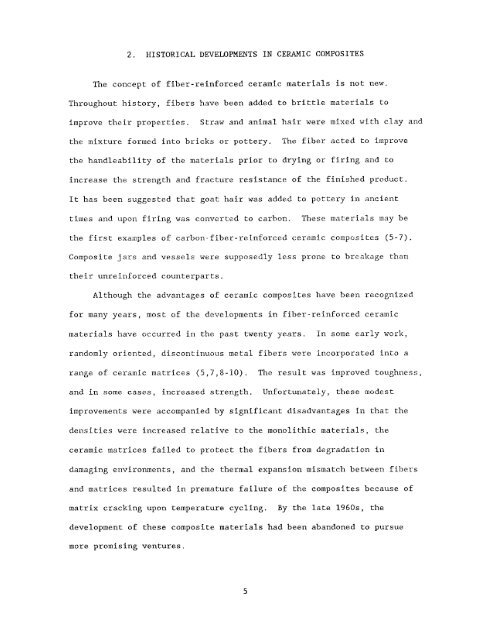Characterization and control of the fiber-matrix interface in ceramic ...
Characterization and control of the fiber-matrix interface in ceramic ...
Characterization and control of the fiber-matrix interface in ceramic ...
You also want an ePaper? Increase the reach of your titles
YUMPU automatically turns print PDFs into web optimized ePapers that Google loves.
2. HISTORICAL DEVELOPMENTS IN CERAMIC COMPOSITES<br />
??le co.ncept <strong>of</strong> <strong>fiber</strong>-re<strong>in</strong>forced <strong>ceramic</strong> materials i.s not new.<br />
Throughout history, <strong>fiber</strong>s have been added to brittle materials to<br />
improve <strong>the</strong>ir properties.<br />
Straw <strong>and</strong> animal hair were mixed with clay <strong>and</strong><br />
<strong>the</strong> mixture formed <strong>in</strong>to bricks or pottery. The <strong>fiber</strong> acted to improve<br />
<strong>the</strong> h<strong>and</strong>leability <strong>of</strong> <strong>the</strong> materials prior to dry<strong>in</strong>g or fir<strong>in</strong>g <strong>and</strong> to<br />
<strong>in</strong>crease <strong>the</strong> strength <strong>and</strong> fracture resistance <strong>of</strong> <strong>the</strong> f<strong>in</strong>ished product.<br />
It has been suggested that goat hair was added to po,ttery <strong>in</strong> ancient<br />
times <strong>and</strong> upon fir<strong>in</strong>g was converted to carbon.<br />
These mat:erials may be<br />
<strong>the</strong> first examples <strong>of</strong> carbon-<strong>fiber</strong>-re<strong>in</strong>forced eerami.~ composites (5-7).<br />
Composite jars <strong>and</strong> vessels were supposedly less prone to breakage than<br />
<strong>the</strong>ir unre<strong>in</strong>forced counterparts.<br />
Although <strong>the</strong> advantages <strong>of</strong> <strong>ceramic</strong> camposltes have been recognized<br />
for many years, most <strong>of</strong> <strong>the</strong> developments <strong>in</strong> fi.l>er-re<strong>in</strong>forced <strong>ceramic</strong><br />
materials have occurred <strong>in</strong> <strong>the</strong> past twenty years, In some early work,<br />
r<strong>and</strong>omly oriented, discont<strong>in</strong>uous metal <strong>fiber</strong>s were <strong>in</strong>corporated <strong>in</strong>to a<br />
range <strong>of</strong> <strong>ceramic</strong> matrices { 5,7,8-10). The result was improved toughness,<br />
<strong>and</strong> <strong>in</strong> some cases, <strong>in</strong>creased strength, Unfortunately, ,<strong>the</strong>se i~iodest<br />
improvements were accompanied by significant disadvantages <strong>in</strong> that <strong>the</strong><br />
densities were <strong>in</strong>creased relati.ve to <strong>the</strong> monolithic materials, <strong>the</strong><br />
<strong>ceramic</strong> matrices failed to protect <strong>the</strong> <strong>fiber</strong>s from degradation <strong>in</strong><br />
damag<strong>in</strong>g environments, <strong>and</strong> <strong>the</strong> <strong>the</strong>rmal expansion mismatch between <strong>fiber</strong>s<br />
<strong>and</strong> matrices resulted <strong>in</strong> premature failure <strong>of</strong> <strong>the</strong> composites because <strong>of</strong><br />
<strong>matrix</strong> crack<strong>in</strong>g upon temperature cycl<strong>in</strong>g. By <strong>the</strong> late 1960s, <strong>the</strong><br />
development <strong>of</strong> <strong>the</strong>se composite materials had been ab<strong>and</strong>oned to pursue<br />
more promis<strong>in</strong>g ventures.<br />
5

















